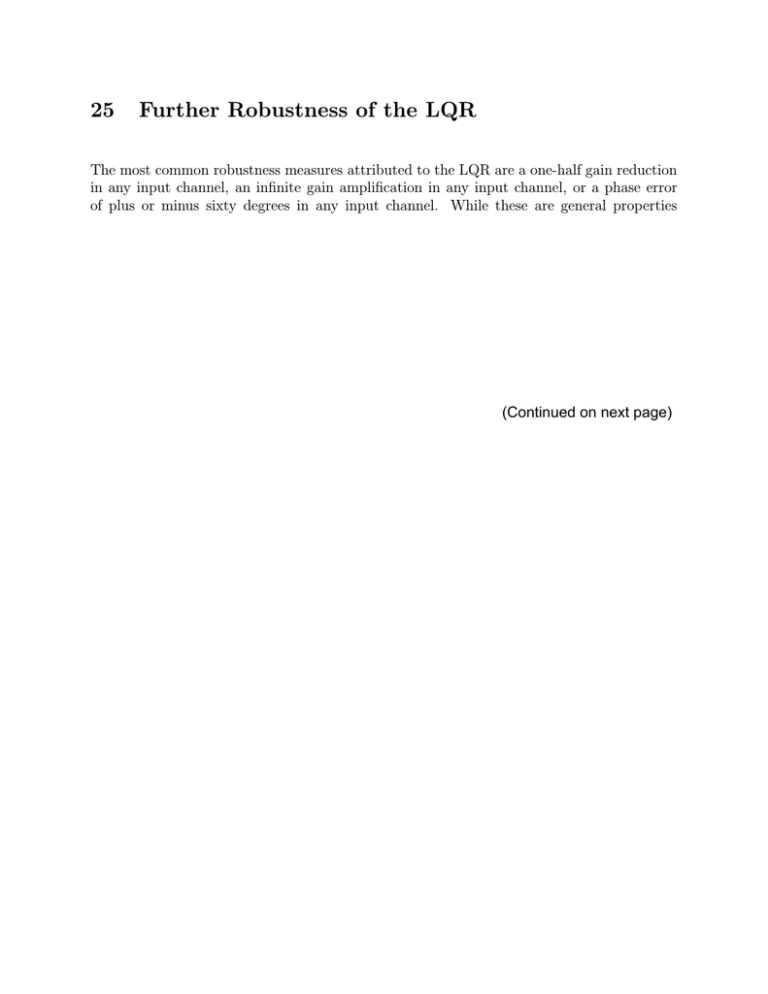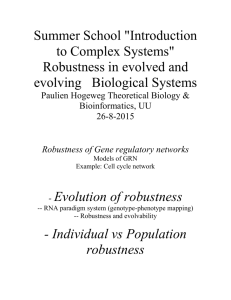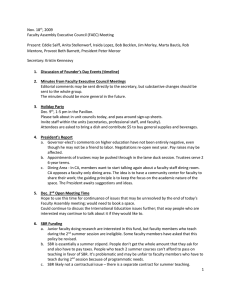Document 13359394
advertisement

25 Further Robustness of the LQR The most common robustness measures attributed to the LQR are a one-half gain reduction in any input channel, an infinite gain amplification in any input channel, or a phase error of plus or minus sixty degrees in any input channel. While these are general properties (Continued on next page) 134 25 FURTHER ROBUSTNESS OF THE LQR that have a clear graphical implication on the Bode or Nyquist plot, other useful robustness conditions can be developed. These include robustness to uncertainty in the real coefficients of the model (e.g., coefficients in the A matrix), and certain nonlinearities, including control switching and saturation. We will use the Lyapunov stability and the LMI formulation of matrix problems in this section to expand these ideas. Saturation nonlinearities in particular are ubiquitous in control system application; we find them in ”railed” conditions of amplifiers, rate and position limits in control surface actuators, and in well-meaning but ad hoc software limits. As shown below, moderate robustness in saturation follows from the basic analysis, but much stronger results can be obtained with new tools. When the LQR is used to define the loop shape in the loop transfer recovery method (as opposed to the Kalman filter in the more common case), these robustness measures hold. 25.1 Tools 25.1.1 Lyapunov’s Second Method The idea of Lyapunov’s Second Method is the following: if a positive definite function of the state γx can be found, with V (γx) = 0 only when γx = γ0, and if dV (γx)/dt < 0 for all time, then the system is stable. A useful analogy for the Lyapunov function V (γx) is energy, dissipated in a passive mechanical system by damping, or in a passive electrical system through resistance. 25.1.2 Matrix Inequality Definition Inequalities in the case of matrices are in the sense of positive and negative (semi) definite­ ness. Positive definite A means γx T Aγx > 0 for all γx; positive semidefinite A means γx T Aγx → 0 for all γx. With A and B square and of the same dimension, A < B means γx T Aγx < γx T Bγx, for all γx. (300) Also, we say for the case of a scalar ρ, A < ρ means A − ρI < 0. 25.1.3 (301) Franklin Inequality A theorem we can use to assist in the Lyapunov analysis is the following, attributed to Franklin (1969). 1 AT B + B T A √ ρAT A + B T B, for all real ρ > 0. ρ (302) The scalar ρ is a free parameter we can specify. It is assumed that the matrices A and B are of consistent dimensions. 25.1 Tools 25.1.4 135 Schur Complement Consider the symmetric block matrix defined as follows: M= ⎬ A B BT D � . (303) The Schur complements of blocks A and D are defined, respectively, as �A = D − B T A−1 B �D = A − BD −1 B T , (304) M > 0 ⇒∀ �A > 0 and �D > 0 and A > 0 and D > 0. (305) and an important property is that The Schur complements thus capture the sign of M , but in a smaller dimensioned matrix equation. The fact that both A and D have to be positive definite, independent of the Schur γ 1×nA γ01×nD ]T , complements, is obvious by considering γx that involve only A or D, e.g., γx = [1 where nA and nD are the dimensions of A and D. 25.1.5 Proof of Schur Complement Sign It is easy to verify that M= ⎬ A B BT D � = ⎬ I 0 B T A−1 I �⎬ A 0 0 D − B T A−1 B �⎬ I A−1 B 0 I � (306) The outer matrices are nonsingular so there is a one-to-one transformation γz = ⎬ I A−1 B 0 I � γx, (307) and thus M > 0 is equivalent to A > 0 and �A > 0. The proof for �D is completely analogous. 25.1.6 Schur Complement of a Nine-Block Matrix For the purposes of derivation below, consider now the symmetric matrix � ⎭ A B C ⎛ T ⎞ M = ⎝ B D 0 ⎠. CT 0 E (308) Using the Schur complement of the diagonal block including D and E, we have M > 0 ⇒∀ A − BD −1 B T − CE −1 C T > 0 and D > 0 and E > 0. (309) Again, positive definiteness of a large matrix is reflected in a smaller matrix inequality. 136 25.1.7 25 FURTHER ROBUSTNESS OF THE LQR Quadratic Optimization with a Linear Constraint Consider the quadratic function V = γx T P γx, P symmetric and positive definite, and the minimization of V subject to a constraint γc T γx = a, where γc T is a row vector, and a is a scalar. The solution is: a2 . (310) γc T P −1γc To show that this is true, augment the objective with a LaGrange multiplier to become min V = Ṽ = V + η(γc T γx − a). (311) Setting � V˜ /�γx = 0 gives 2γx T P + ηγc T = 0. Post-multiply this equation by P −1γc, and solve to give η = −2a/γc T P −1γc. Then, using 2γx T P + ηγc T = 0 again, post-multiply by γx/2, and insert η, concluding the proof. 25.2 Comments on Linear Matrix Inequalities (LMI’s) The reason that solving M > 0 is simpler than the equivalent Schur complement inequality is that, as long as M (γy) is affine in the unknowns γy, the solution set is convex. Affine means that M (γy) = Mo + K[yγ γy ... γ]N, y (312) i.e., that M is a constant matrix plus terms linear in each element of γy. Note the matrices K and N here, as well as the columnwise expansion of γy, are needed to put elements of γy in arbitrary locations of M . Convex means that if γy1 and γy2 are feasible solutions to the inequality, then so is γy3 = ∂γy1 + (1 − ∂)γy2 , for any ∂ between zero and one. A convex solution set has no hidden corners or shadows, because every point on a straight line between two solutions is also a solution. Computer programs solving convex optimization problems can always get the global optimum efficiently, or determine that no solution exists. From the Schur complements above, clearly we can transform a (suitable) matrix equation that is quadratic or higher in the unknowns into an affine M (γy ), and therefore make an efficient solution. The term linear matrix inequality refers of course to the fact that M is affine and hence linear in the unknown variables, but also to the methods of analysis and numerical solution, wherein the idea is to recognize M (γy ) = Mo + M1 y1 + M2 y2 + ...Mn yn , (313) where n is the dimension of the unknown vector γy. Example. Consider the LMI M (γy) = ⎬ y1 − 1 2y2 − 1 y2 + 1 y 2 − y 1 � > 0. (314) 25.3 Parametric Uncertainty in A and B Matrices 137 We use the theorem that M > 0 is achieved if each of the submatrices cornered at the (1,1) element has positive determinant. Then M > 0 is equivalent to y1 > 1 (y1 − 1)(y2 − y1 ) − (2y2 − 1)(y2 + 1) > 0. (315) The solution set is shown as S in the figure below; M is affine in γy and the solution set is convex. 1.5 1 S y2 0.5 0 −0.5 −1 −1.5 −0.5 0 0.5 y 1 1.5 1 25.3 Parametric Uncertainty in A and B Matrices 25.3.1 General Case Let S be the solution to the matrix Riccati equation AT S + SA + Q − P BR−1 B T P = 0. (316) We consider here perturbations to the design plant matrices A and B of the form γẋ = (A + �A)γx + (B + �B)γu. The control in the LQR is γu = −R −1 B T P γx. Select a Lyapunov function of the form V (γx) = γx T Sγx. Then V̇ T = γ̇x Sγ x + γx T Sγẋ � = γx T AT S + SA + �AT S + S�A − 2SBR−1 B T S− � SBR−1 �B T S − S�BR−1 BS γx. We give the following special structures to the perturbations: (317) 138 25 FURTHER ROBUSTNESS OF THE LQR �A = DA �A EA �B = DB �B EB . (318) The idea is to capture all of the uncertainty in �A and �B and capture the structure of the perturbations using the other four matrices. We have, using the Franklin inequality, V̇ � T = γx T AT S + SA − 2SBR−1 B T S + EAT �TA DA S + SDA �A EA � T −SBR−1 EBT �TB DB S − SDB �B EB R−1 BS γx √ γx T ⎬ AT S + SA − 2SBR−1 B T S + ρA EAT �TA �A EA + 1 T SDA DA S ρA � 1 T +ρB SBR + SDB DB S γx ρB ⎬ 1 T T SDA DA √ γx AT S + SA − 2SBR−1 B T S + ρA EAT EA + S ρA � 1 T −1 T −1 T +ρB SBR EB EB R B S + SDB DB S γx, ρB −1 EBT �TB �B EB R−1 B T S (319) (320) where the last inequality holds if �TA �A √ I, �TB �B √ I. (321) (322) For a given perturbation model with matrices DA , EA , DB , and EB , we thus obtain a matrix inequality which, if met, guarantees stability of the system for all γx: 1 T S SDA DA ρA 1 T +ρB SBR−1 EBT EB R−1 B T S + SDB DB S < 0. ρB AT S + SA − 2SBR−1 B T S + ρA EAT EA + (323) Since scalars ρA and ρB can take on any positive value, they remain to be picked, and in fact judicious choices are needed to maximize the robustness guarantees – i.e., to minimize the conservativeness. 25.3.2 Uncertainty in B Putting aside �A for the moment, and substituting in the Ricatti equation into the above leads to 25.3 Parametric Uncertainty in A and B Matrices 139 −Q − SBR−1 B T S + ρB SBR−1 EBT EB R−1 B T S + 1 T S < 0. SDB DB ρB (324) Following the presentation of gain and phase margins of the LQR in a previous section, we here consider gain margins through the diagonal matrix N , such that �B = BN = B � R−1 |N | ×I × � R|N | = DB �B EB . (325) |N | denotes the matrix made up of the absolute values of the elements of N . This �B is a very specific structure, whose rationale becomes evident below. The stability inequality becomes −Q − SBR−1 B T S + ρB SB |N |R−1 B T S + 1 SBR−1 |N |B T S < 0, ρB (326) or, equivalently, I − ρB |N | − 1 |N | > 0, ρB (327) because Q can be arbitrarily small in the LQR; certainly a large value of Q increases the robustness (see the case of �A below, for example). Since N is diagonal, it is sufficient to keep all � 1 1 − |Ni,i | ρB + ρB � > 0. (328) , (329) Solving for ρB gives ρB = 1± � 2 1 − 4Ni,i 2|Ni,i | showing that real, positive ρB are attained for |Ni,i | < 1/2. Hence, this analysis confirms the one-half gain reduction property derived earlier. On the other hand, it confers only a one-half gain amplification robustness, which is overly conservative. Usage of the Franklin inequality to symmetrize the components involving �B is the cause of this, since it can be verified that using Equation 319 directly gives −Q − SBR−1 (I + N + N )B T S < 0, or 1 + 2Ni,i > 0, (330) showing both the one-half reduction and infinite upward gain margins. In summary, in the special case of diagonal N in the model of �B, we crafted DB and EB so as to align terms of the form SBR−1 B T S, simplifying the analysis. This leads to a conservative result using the Franklin inequality, but the full, standard result on a second look. Better results could be obtained for specific cases, but probably with greater effort. 140 25.3.3 25 FURTHER ROBUSTNESS OF THE LQR Uncertainty in A Uncertainty in the system matrix A has a different role in robustness than does uncertainty in B, which is primarily an issue of gain and does not affect the open-loop stability. Pertur­ bations to the design matrix A cause the open- and closed-loop poles to move, potentially destabilizing either or both of the open- and closed-loop systems. Consider the main in­ equality for stability again, setting aside �B now: −Q − SBR−1 B T S + ρA EAT EA + 1 T SDA DA S < 0. ρA (331) Aligning the uncertain terms with SBR−1 B T S (as with �B above) proves to be impractical here because it imposes a specific structure on �A, and requires that elements of �A would have to change together. A more useful result involves a diagonal �A , and for the purposes of illustration, we consider a second order system as follows: �A = D A �A E A = = ⎬ d 1 ζ1 d 2 ζ2 0 0 ⎬ d1 d2 0 0 � . �⎬ ζ1 0 0 ζ2 � I (332) (333) In addition, we set B = [b 0]T , so that R is a scalar r, and we set Q diagonal. The resultant inequality is −Q + ρA I − S �⎬ b2 /r 0 0 0 � − ⎬ (d21 + d22 )/ρA 0 0 0 �� S < 0. (334) The condition for stability will be met if Q − ρA I > 0 and b2 /r − (d21 + d22 )/ρA > 0, or equivalently, setting ρA = min Qi,i , if b2 min Qi,i > d21 + d22 . r (335) Now let, for example, A = ⎬ −0.5 −0.5 1 0 � , B = [1 0]T Q = diag(1, 1) R = 1. This informs us that the robustness condition is d21 + d22 < 2, and very substantial perturba­ tions in A are allowed, for example 25.3 Parametric Uncertainty in A and B Matrices A + �A = ⎬ 141 0.5 0.5 1 0 � . 2 2 1 1 Imag(s) Imag(s) Computed results that confirm the bound are shown in Figure 9. An interesting note is that the gain reduction margin in the presence of this �A suffers dramatically, with failure of the robustness if b < 0.93. Intuitively, the uncertainty in A has used up almost all of the available safety margin. 0 −1 −1 −2 0 −3 −2 −1 Re(s) 0 1 −2 −3 −2 −1 Re(s) 1 0 Figure 9: (left) open-loop pole locations along the boundary of the stability region in Equation 335; (right) closed-loop pole locations with LQR. 25.3.4 A and B Perturbations as an LMI Using the triple LMI of Equation 309, we have, for the combined A and B structured uncertainty models, 1 T SDA DA S ρA 1 T +ρB SBR−1 EBT EB R−1 B T S + SDB DB S < 0 ρB −Q − SBR−1 B T S + ρA EAT EA + (336) is equivalent to � ⎭ −Q − SBR−1 B T S + ρA EAT EA + ρB SBR−1 EBT EB R−1 B T S SDA SDB ⎛ T S −ρA I 0 ⎞ DA ⎠ < 0. (337) ⎝ T S 0 −ρB I DB The solution set [ρA ρB ], if it exists, is convex. If a solution does not exist, one could lower the robustness by altering DA , EA , DB , or EB . Alternatively, increasing Q, the state penalty, where possible may increase robustness. 142 25.4 25 FURTHER ROBUSTNESS OF THE LQR Input Nonlinearities Control systems in practice often make use of switched or saturated action in the control channels. Switched and saturated control channels are defined respectively as switch(u, U ) = U sign(u), (338) and sat(u, U ) = U sat(u/U, 1) = � u, |u| < U , U sign(u), |u| > U. (339) where the scalar U is positive. If the second argument of sat(·) is omitted, it is taken to be one. switch(u,U) sat(u,U) U U -U U u -U u -U Our stability analysis so far is one wherein we seek to guarantee a negative rate in V (γx) for all time. Referencing Equation 330, it is clear that any N can be tolerated within the range (−.5, ∗), even if it is time varying. It follows directly then that switching and saturated control channels cannot destabilize the LQR system until the gain reduction is more than one-half, that is, |u| > 2U . In practice, however, systems routinely operate beyond this point, and this is the aspect of saturated control in particular that we wish to pursue now. This section details the approach of Huang & Lam (2002), which uses LMI’s and the structured uncertainty models above. We say that f (γu) is the diagonal function taking control commands from the LQR (γu) to the input to the plant; elements of f correspond to the saturated operator above. Through scaling the B matrix, we can set Ui = 1, and hence f ’s extreme outputs are ±1. First, we assert that under the proper choice of positive definite matrix W , and for certain vectors γz, the following inequality holds: 2γzT f (R−1γz) → γzT W R−1γz. (340) If the control penalty matrix R is diagonal, and we constrain W also to be diagonal, this condition is met if, for each control channel, � zi 2zi sat Ri,i � → zi2 Wi,i . Ri,i (341) 25.4 Input Nonlinearities 143 If the channel is not saturated, then we require Wi,i √ 2. If the channel is saturated, then it is required instead that � � � Ri,i � � � 2 � � zi → Wi,i . (342) We will use the inequality of Equation 340 in our Lyapunov analysis, with special attention to these conditions. Because for the LQR we have zi = eTi B T Sγx, where ei is the unit vector in the i’th direction, Equation 342 effectively places a bound on the state under saturated control, namely |eTi B T Sγx| √ 2Ri,i /Wi,i . (343) Viewed this way, clearly we would like to make each Wi,i as small as possible. As we show below, however, the matrix W appears in the only negative term of V̇ (γx); the optimization then is to maximize the state space satisfying Equation 342, while keeping W big enough to guarantee stability. With V (γx) = γx T Sγx, and considering uncertainty �B only, we have V̇ (γx) = γx T (SA + AT S)γx − 2γx T SBf (R−1 B T Sγx) − 2γx T S�Bf (R−1 B T Sγx). (344) Note that �B never appears inside f because f operates on the control u, calculated with B alone. Applying the Franklin inequality to the last term yields V̇ (γx) √ γx T (SA + AT S)γx − 2γx T SBf (R−1 B T Sγx) 1 T −1 T T +ρB γx T SDB DB Sγx + f (R B Sγx)EBT EB f (R−1 B T Sγx)). ρB (345) Next, consider the remaining asymmetric term. Applying Equation 340, under the proper constraints on W , we obtain V̇ (γx) √ γx T (SA + AT S)γx − γx T SBW R−1 B T Sγx 1 T −1 T T +ρB γx T SDB DB Sγx + f (R B Sγx)EBT EB f (R−1 B T Sγx)). ρB (346) Finally, the last term is bounded, giving T SA + AT S − SBW R−1 B T S + ρB SDB DB S+ 1 SBR−1 EBT EB R−1 B T S < 0 ρB (347) as the sufficient condition for stability. This last step is extremely conservative, since in fact |fi | √ 1; Huang and Lam address this point. 144 25 FURTHER ROBUSTNESS OF THE LQR The supporting conditions on elements of W are linear: Wi,i must be as in Equation 342, and less than two. As noted above, these translate to linear constraints on γx. Call the set of states that satisfy these conditions Ω. The problem now is that although the Lyapuonov function derivative is clearly less than zero for states within Ω, the state trajectory could leave Ω. This is entirely likely since V is a quadratic function, leading to elliptical contours as in the figure below. x2 V contours Vmax Ψ x1 As a result, the range of states leading to guaranteed stability is limited to those that are known not to leave Ω. In other words, we have to settle for the largest ellipse completely contained in Ω. We now invoke Equation 310, referencing Equation 343 as the set of linear constraints, to yield Vmax = mini 2 4Ri,i 2 T T Wi,i ei B SBei (348) We would like to maximize Vmax , which is equivalent to maximizing the minimum value of all the possible right hand sides of the above equation. This itself can be posed as an optimization in a new scalar k: 1 (349) minimize k such that kI − R−1 W � > 0, 2 � where � is diagonal, with �i,i = eTi B T SBei . It follows that any γx is stable when V (γx) = γx T Sγx < 1/k 2 . In summary, we have three constraints and one optimization: Equation 347 for Lyapunov stability, 0 √ Wi,i √ 2 for cases where channels are not saturated, and Equation 349 for maximizing the level of V - an elliptical region in the state space - for which stability is guaranteed. As in the case of no input saturation, this can be posed and solved as set of LMI’s (which itself can be posed as a single LMI): ⎬ � T S SBR−1 EBT SA + AT S − SBW R−1 B T S + ρB SDB DB EB R−1 B T S ρB I 1 −1 R W� 2 W 0 < 0, (350) < k, (351) < 2, < W. (352) (353) 25.4 Input Nonlinearities 145 To solve, pick a value for k and find a feasible solution. Decrease k as far as possible; the feasible solution achieves the maximum V from which the range of state space can be found from V = 1/k 2 .




